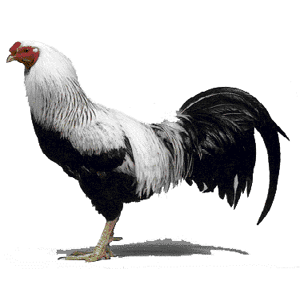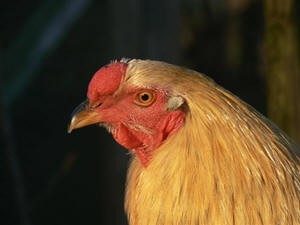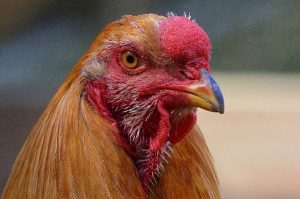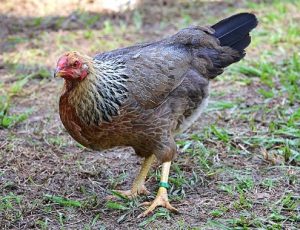
Breed Overview
History
The Kraienkoppe or Twentse chickens are medium weight birds, bred in the 19th Century in the border area between Holland and Germany. In the German county of Bentheim this chicken is called Kraienkoppe, whilst the Dutch call it Twentse (short for Twentse Hoenkrielen). Bentheim in Lower Saxony Germany is right beside the Dutch border provinces of Overijssel and Drenthe and the district of Emsland.
Kraienkoppe/Twentse chickens should ideally be slender and graceful, and are often quite tall, as they were bred from Malay birds, local crosses and later Silver Duckwing Leghorn to improve egg laying performance.
These tall chickens were also very popular for cockfighting with the many textile workers who lived and worked in the border areas, until cockfighting was banned by The Dutch Government in 1849.
Available in both a large breed which was recognised in 1924 and bantam size, which was recognised in 1941.
Key attributes
These chickens have a small round head with a fairly broad skull, and a walnut shaped combe that looks like half a red strawberry. Because of this typical small and compact combe shape there is little chance of it freezing in cold winters. This has led to the nickname ‘winter layer’ Kraienkoppe/Twentse are noted for having enormous vitality. Plus too a great resistance to cold weather and diseases.
Because they can continue laying eggs in winter, this has made them popular across Germany, Holland and Europe, both for meat and eggs.
Kraienkoppe/Twentse can be very tame and well behaved with humans if hand raised as chicks. These birds are not great flyers and high protective fencing is only necessary to keep predators at bay.
Breed standards state that mature cocks will typically weigh up to 6.6 pounds (3 kg) and mature hens around 4 pounds (1.8 kg), bantam cocks around 2.2 pounds(1 kg) and bantam hens around 1.5 pounds (0.7 kg).
Kraienkoppe/Twentse chickens are mostly kept by backyard chicken enthusiasts for their good rate of egg production and hardiness.
In the UK it can be quite challenging to find pure bred Kraienkoppe/Twentse chickens for sale, as there are many cross breeds. In the USA the Kraienkoppe/Twentse is a rare breed and there are very few breeders with flocks.
Bantams
The Bantam has exactly the same looks and proportions as the large chicken, but in a much smaller size and lays eggs that are only 0.7 ounces (20 gms) smaller than the large hen birds. Mature males can be up to 25 inches (63 cms) tall and mature hens up to 20 inches (50 cms) tall).
Eggs
Size
Eggs are medium to large in size weighing around 1.9 ounces (55gms), with bantams laying medium size eggs weighing 1.2 (35 gms).
Color
Eggs are usually cream colored or white, sometimes with speckles
Production per year
Up to 190 eggs per year, for first four years.
When do they start laying eggs?
From 5 months and egg laying rate can slow down considerably after hens are over four years old.

Kraienkoppe/Twentse Characteristics
Temperament / Are they good as pets
Kraienkoppe/Twentse chickens can make very good pets if raised by hand as chicks. These can be stunning looking birds in certain plumage colors and are much admired for their good looks. Like many cockerels Kraienkoppe/Twentse cocks can become muscular birds and develop a territorial nature and aggressive behaviour with other males.
Kraienkoppe/Twentse hens are considered to be good mothers and generally get along quite well together, although they can go broody regularly. One cockerel for around 5 hens is a good ratio.
The Kraienkoppe/Twentse is a confident bird who likes exploring, and if given the opportunity will quickly wander off. Given enough securely fenced space to roam and not too closely confined, the Kraienkoppe/Twentse will do well as an addition to a backyard flock.
The Kraienkoppe/Twentse has a reputation as a highly productive egg layer, requiring only a medium quantity of feed if allowed to actively forage in warmer months.
How do I tame “Kraienkoppe/Twentse” chickens?
The best way to tame a chicken is to handle it when it is still young; this gets your chickens used to people. If you have older chickens that need taming, try feeding them out of your hand regularly.
Kraienkoppe/Twentse can become very tame and as a confident bird will often just stand and face humans without showing any fear.
How many do I need to buy?
2 chickens are the absolute minimum you need for a flock, we recommend around 5 as a small flock number.
How much space do they need?
These are large birds but interestingly don’t mind being confined in medium sized chicken coops, so ideally 4 square feet minimum per mature bird in a coop. In a run around 20 square feet minimum per bird, with good outside access to prevent boredom. Kraienkoppe/Twentse love being outside exploring and foraging for food. Luckily Kraienkoppe/Twentse don’t fly much. Unless they are in in danger, so high -level containment fencing is no required. Really anything above 5 feet (150 cms) is not necessary.
Will they mix with my other chickens?
In general Kraienkoppe/Twentse will get along well with other breeds of chickens, as long as there is no other male cockerel to cause aggressive behaviour. Kraienkoppe/Twentse and other breeds will usually get along fine. So long as they are not too closely confined and there is adequate room to explore and prevent boredom.
Appearance
Kraienkoppe/Twentse chickens have yellow skin and yellow or off-white feet. Their plumage comes in a wide variety of colors, with some breeders claiming that ginger (red) breasted birds become heavier and better egg-layers than silver breasted hens.
APA recognised colors within the breed are: partridge, silver partridge, blue partridge, blue/silver partridge, yellow/ginger (red) partridge, white grey partridge, black and pure white.
These chickens are normally of a calm disposition, but they can sometimes be theatrically aggressive, energetic and proud, showy birds. Silver and Gold were the original colours but Blue Red, white and Blue Silver Duckwing are available in Europe. Grey, white and black feathered birds were also common in the 1920s and these have recently become popular again with breeders.
Plumage cover is good over the whole body and the feathers provide good cold weather insulation and protection from light rain, making this breed a hardy “winter layer”.

Feeding
What should I feed them?
When you first get your chickens home you should feed them growers mash, as it has a higher percentage of protein (19{cfcd481556a8b43fba6af451761032bd323e94372a0c1e607}). It is refined so that it can be easily ingested.
You should feed them growers mash up until 6 weeks. Then they should be fed chicken pellets which is just feed in pellet form, this has between 15-16{cfcd481556a8b43fba6af451761032bd323e94372a0c1e607} protein.
At 18 weeks your chickens need more nutrients to help with egg production. So slowly start feeding them layers mash or pellets which has around 16{cfcd481556a8b43fba6af451761032bd323e94372a0c1e607} protein.
Chickens will need access to fresh drinking water all day long, they will prefer cool drinking water, no one is quite sure why maybe it’s a prehistoric throwback. It is important to have the feed and water at the proper height for all birds in the pen. Ideally feed and water should be at back level. If the water is too low down, chickens may scratch litter into it and the water will go bad quickly.
Your chickens also need grit to help with egg production, so make sure there is always some within easy access for them at all times. Kraienkoppe/Twentse are excellent foragers and love being outside hunting for insects, slugs, snails and bugs to eat.

How much should I feed them?
Kraienkoppe/Twentse are large birds, but surprisingly don’t have a huge appetite. They eat anywhere between 4 oz (113g) and 6 oz (170g) a day. On average breeders feed their chickens 5 oz (140g) a day. Start by feeding them this and then adjust the weight of feed around how much they consume.
You can leave the feed in a feeder for them to eat whenever they please. Or you can give them set meal times. Shamo love to forage outside for grubs and bugs.
Your chickens also need grit to help with egg production, so make sure there is always some in easy reach.
What can’t they eat?
Chocolate and beans are the two main foods that shouldn’t be eaten by chickens. The phytohemagglutinin in beans can lead to fatalities and the theobromine in chocolate can cause heart problems. Moldy food that has bad bacteria in it should not be fed to chickens as it can make them very unwell. For this reason, it is illegal to feed your chickens leftovers in the UK.
What do I need to keep chickens?
The most essential item you need to keep chickens is a coop! This should ideally be 0.4 m2 or 4 square feet per chicken. Their run needs 20 square feet (1.9 m2 ) per chicken. In the coop they should have a perch to sleep on and a wooden laying box for their eggs.
You should invest in a sunken fence to go over and around the coop to keep them safe at night. Find a water bowl which they can’t stand in or push over and place it in the shade. This will keep the water from getting too warm.
Feed and water for Kraienkoppe/Twentse are best placed off the ground, at around the ‘back’ height of the bird. Raised feed and water bowl holders are easily obtained.
